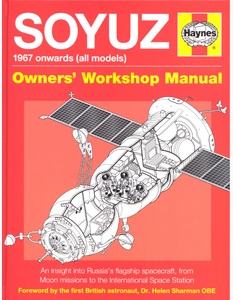The Russian Soyuz spacecraft deserves its inclusion in the growing list of Haynes Workshop Manuals dedicated to spacecraft (as opposed to motor vehicles, as per the original intent), because it is arguably the most venerable of all spacecraft. It is, of course, still being used – albeit in updated form - after more than 50 years of service, as reflected by the subtitle of this book: “1967 onwards (all models)”.
In her foreword, British astronaut Helen Sharman writes that, during her training in Russia’s Star City, she would “long for something as detailed and complete for the Soyuz TM-12” as she had for her first motorbike. Although this manual would not have helped much with practical Soyuz repair and maintenance, it’s a nod in the right direction.
The book is well illustrated with monochrome and colour photographs and the usual gamut of line drawings expected in a Haynes manual. There are fewer detailed subsystem diagrams than in the typical manual of this type, probably because of the difficulty of obtaining them from the manufacturer, but there are enough credited to the Energia company to make it feel authentic.
The book is structured chronologically to include the main Soyuz variants (7K, T, TM, TMA, etc) in separate chapters, prefaced by a historical introduction and a chapter on Vostok and Voskhod (forerunners of the Soyuz). It might seem like ‘padding’ to include these 45 pages that aren’t on the subject of the manual, but that would be to assume that this actually is a workshop manual. Likewise, most readers will find that the information on Russia’s LK Moon lander, the N1 launch vehicle, the Sokol spacesuit and the Apollo-Soyuz Test Project provides additional interest and context. The volume concludes with a list of abbreviations and an index.
Since this book was published, Russia has announced the development of its Federation spacecraft as a replacement for the venerable Soyuz, but it promises to remain operational for a while yet and to live on in the guise of the Chinese Shenzhou which owes its basic design to the Soyuz. One day, an update to this Soyuz manual might include such developments and change of that subtitle from “onwards” to a specific date; until then, it provides a good historical and technical overview of this long-running spacecraft.
Mark Williamson, Space Technology Consultant











